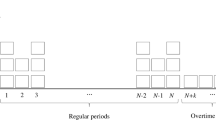Abstract
In the presence of different service times of regular patients and nonpreemptive priority of emergency patients at the same day, this paper considers an advance appointment-scheduling problem of medical resources in which a finite amount of same-day service capacity should be allocated to different patients. This booking problem is modeled as a dynamic programming (DP) problem. The structural properties of DP model analytically reveal a booking limit policy. The booking limit numbers of regular patients do not monotonically increase with their revenues because of the service time differences. A numerical analysis is provided to test the performance of our booking limit policy by comparing polices in previous studies. Simulation results show that our policy provides a positive improvement in terms of the total reward of the service system, even when patients do not have perfect adherence to appointments (e.g., patient no-shows and unpunctuality). The numerical experiments demonstrate that the dedicated medical resource cannot improve emergency patients’ access to service but deteriorated their direct waiting time.
Similar content being viewed by others
References
Cayirli T, Veral E (2003) Outpatient scheduling in health care: a review of literature. Product Oper Manage 12(4):519–549
Dobson G, Hasija S, Pinker E (2011) Reserving capacity for urgent patients in primary care. Product Oper Manage 20:456–473
Gerchak Y, Gupta D, Henig M (1996) Reservation planning for elective surgery under uncertain demand for emergency surgery. Manage Sci 42(3):321–334
Green L, Savin S, Wang B (2006) Managing patient demand in a diagnostic medical facility. Oper Res 54:11–25
Gupta D, Denton B (2008) Appointment scheduling in health care: challenges and opportunities. IIE Trans 40:800–819
Gupta D, Wang L (2008) Revenue management for a primary-care clinic in the presence of patient choice. Oper Res 56:576–592
Kim SH, Whitt W, Cha WC (2018) A data-driven model of an appointment-generated arrival process at an outpatient clinic. INFORMS J Comput 30(1):181–199
Kong QX, Li S, Liu N, Teo CP, Yan ZZ (2020) Appointment Scheduling Under Time-Dependent Patient No-Show Behavior. Management Science
Kolisch R, Sickinger S (2008) Providing radiology health care services to to stochastic demand of different patient classes. OR Spectrum 30(2):375–395
LaGanga LR, Lawrence SR (2012) Appointment overbooking in health care clinics to improve patient service and clinic performance. Product Oper Manage 21(5):874–888
Lin XM (2014) A study of scheduling policies in CT department with simulation. Southwest Jiaotong University Master Degree Thesis. ChengDu (in chinese)
Luo J, Kulkarni V, Ziya S (2012) Appointment scheduling under patient no-shows and service interruptions. Manuf Serv Oper Manage 14:670–684
Magerlein JM, Martin JB (1978) Surgical demand scheduling: a review. Health Serv Res 13:418–433
Pan XW, Geng N, Xie XL, Wen J (2019) Managing appointments with waiting time targets and random walk-ins. Omega. https://doi.org/10.1016/j.omega.2019.04.005
Patrick J, Puterman ML, Queyranne M (2008) Dynamic multipriority patient scheduling for a diagnostic resource. Oper Res 56:1507–1525
Wang S, Liu N, Wan GH (2019) Managing appointment-based services in the presence of walk-in customers. Management Science
Zhou J (2016) Study on Capacity Management of CT Department with Emergency Non-preemptive Priority. Southwest Jiaotong University Doctor Degree Thesis. ChengDu (in chinese)
Zhou J, Li J, Guo P, Lin XM (2017) The booking problem of a diagnostic resource with multiple patient classes and emergency interruptions. Comput Ind Eng 105:277–286
Acknowledgements
This research was partially supported by National Science Foundation of P.R.China (71601135, 71671146,71532007), National Social Science Foundation of P.R.China (20BGL109,15BGL198), MOE Project of Humanities and Social Sciences (16YJC630180), The Talent Introduction Foundation of SUSE (2017RCL55). We thank the administrators, medical staff at Sichuan Provincial People’s Hospital for their contribution to this work.
Author information
Authors and Affiliations
Corresponding author
Additional information
Publisher's Note
Springer Nature remains neutral with regard to jurisdictional claims in published maps and institutional affiliations.
Supplementary Information
Below is the link to the electronic supplementary material.
Rights and permissions
About this article
Cite this article
Zhou, J., Guo, P. Capacity management of CT department with service time differences and emergency nonpreemptive priority. Flex Serv Manuf J 34, 960–978 (2022). https://doi.org/10.1007/s10696-021-09416-9
Accepted:
Published:
Issue Date:
DOI: https://doi.org/10.1007/s10696-021-09416-9




